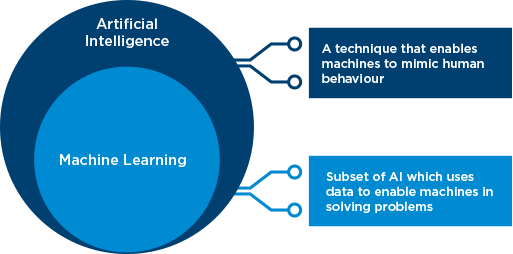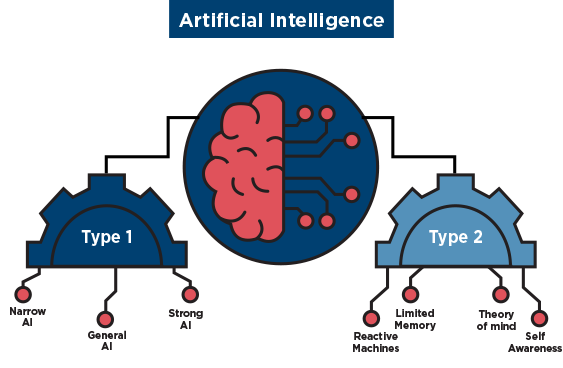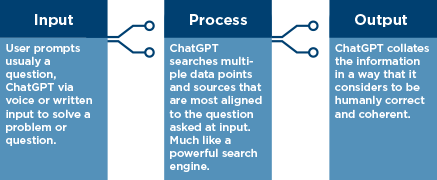What is Artificial Intelligence (AI)?

AI uses computers to imitate the problem-solving and decision-making capabilities of the human mind. While it seems to be a new technology, AI has existed since the 20th century. A common misconception is that machine learning and AI are interchangeable concepts. In fact, machine learning is actually a subset of AI, where a computer develops its own associations or set of processes to solve a problem (termed algorithms), based on data that it is given. AI is the overarching concept of computers performing ‘intelligent’ or human-like cognitive functions, while machine learning is more specifically focused on computer- (as opposed to human) generated algorithms developed or ‘learned’ from data.

Artificial Intelligence

TYPE 1
- Narrow AI is typically programmed to perform one task with great
intelligence. An example is Apple’s Siri. - General AI is programmed to think on its own like a human. It can perform multiple tasks with efficiency. Examples are self-driving vehicles and ChatGPT.
- Strong AI (also referred to as Super AI) is based on the notion that machine intelligence will become greater than human intelligence and can therefore perform tasks better.
TYPE 2
- Reactive systems only provide solutions to problems that arise in the current moment. They do not store historic events for reference.
- Limited memory systems store historic data for a limited time period only before the system refreshes to adapt to a new environment.
- Theory of mind systems comprehend human logic and emotions and use this understanding to create output.
- Self-awareness systems are based on strong AI. They are systems that do not require human input to develop.
1. How generative AI works
The most common type of general AI is known as generative AI, which is commonly represented by systems like ChatGPT and Bard. Generative AI was developed from natural language processing (commonly abbreviated as NLP) but may now be described as natural language understanding. This means that systems like ChatGPT analyse and “understand” human language. This allows them to provide solutions to commands or questions, based on insights generated from multiple sources.


Generative AI fi red up the public imagination when ChatGPT launched in November 2022 and became the fastest service in history to reach 100 million users. This milestone was accomplished in two months. The market has embraced the narrative that companies that use generative AI will be massive beneficiaries of these technological advances. The poster child of this AI excitement has been Nvidia, which is up well over 200% since the
beginning of 2023. Nvidia designs the semiconductors or microchips that are necessary to process graphics. These graphics processing units or GPUs are the hardware required to power generative AI applications like ChatGPT.
2. Common misconceptions





AI is human-like: While AI processes human language and logic, this capability is built on data processing and other parameters set in the respective programming language. It lacks emotions and other subjective cues.
AI will replace human jobs completely: AI is a tool that can be used to enhance human capability and efficiency. Because it is programmed, it is dependent on human input. This opens the door to careers not previously available.
AI is always accurate: AI can make mistakes, especially if trained on biased or limited data. Ensuring the accuracy and fairness of AI systems requires careful development and evaluation.
AI development is expensive and complex: The significant traction of AI means that resources and tools are more accessible and collaboration has increased.
AI is ethically neutral: AI can inherit biases present in the data used for training, and ethical considerations are crucial to ensuring it is used fairly and responsibly.
3. Opportunities
- The shift from interacting with computers through programming code or a graphical interface to natural language commands will make many tasks easier and lower the cost and time of creating code, content, music, and images.
- Generative AI could have a significant and positive impact in many areas, some of which include customer service and support, infrastructure and logistics, personalised medicine, financial services, and media and entertainment.
- Generative AI should drive a dramatic decline in the cost of software development, which until now has constrained software creation. If the cost goes down, we expect a lot more software will be created. We anticipate all the additional software will create opportunities to augment human capabilities and increase productivity, making the world more efficient and capable.
- AI has the potential to be one of the most transformational technologies of the modern age. We need to consider all aspects of this technological evolution, manage it in a responsible and ethical manner and differentiate between tangible value creation and hype.





Comments are closed.